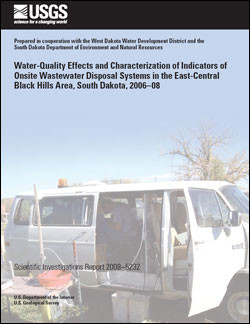
Product Details
- Product Number
- 209294
- Series
- SIR-2009-5111
- Scale
- NO SCALE
- Alternate ID
- SIR2009-5111
- ISBN
- 978-1-4113-2472-5
- Authors
- MIYA N BARR
- Version Date
- 01/01/2009
- Regions
- MO
- Countries
- USA
- Media
- Paper
- Format
- Bound
Additional Details
- Description
- 7/27/2009 Abstract On December 14, 2005, a 680-foot wide section of the upper reservoir embankment of the Taum Sauk pump-storage hydroelectric powerplant located in Reynolds County, Missouri, suddenly failed. This catastrophic event sent approximately 1.5 billion gallons of water into the Johnson's Shut-Ins State Park and into the East Fork Black River, and deposited enormous quantities of rock, soil, and vegetation in the flooded areas. Water-quality data were collected within and below the impacted area to study and document the changes to the riverene system. Data collection included routine, event-based, and continuous surface-water quality monitoring as well as suspended- and streambed-sediment sampling. Surface water-quality samples were collected and analyzed for a suite of physical and chemical constituents including: turbidity; nutrients; major ions such as calcium, magnesium, and potassium; total suspended solids; total dissolved solids; trace metals such as aluminum, iron, and lead; and suspended-sediment concentrations. Suspended-sediment concentrations were used to calculate daily sediment discharge. A peculiar blue-green coloration on the water surface of the East Fork Black River and Black River was evident downstream from the lower reservoir during the first year of the study. It is possible that this phenomenon was the result of 'rock flour' occurring when the upper reservoir embankment was breached, scouring the mountainside and producing extremely fine sediment particles, or from the alum-based flocculent used to reduce turbidity in the lower reservoir. It also was determined that no long-term effects of the reservoir embankment breach are expected as the turbidity and concentrations of trace metals such as total recoverable aluminum, dissolved aluminum, dissolved iron, and suspended-sediment concentration graphically decreased over time. Larger concentrations of these constituents during the beginning of the study also could be a direct result of the alum-based flocculent used in the lower reservoir. Suspended-sediment concentrations and turbidity measurements were largest at the site downstream from the lower reservoir. This is because of the large amounts of debris deposited in the lower reservoir from the breach, which in turn were redeposited into the East Fork Black River during releases. When these constituents were plotted over time, the concentrations decreased and were similar to the other two sites in the study. Trend analyses were studied at one site with historical data. No major trends were discovered for streamflow, turbidity, suspended-sediment concentrations, or suspended-sediment discharges before or after the event. Although long-term effects of the elevated turbidity, major trace metals, and suspended sediments in the study area as a result of the reservoir embankment breach are not expected, there could possibly be other effects not measured during this study that could potentially affect the surface-water quality, such as loss of riparian habitat, changes in biological ecosystems, and large- scale reworking of sediments.
- Survey Date
- 2009
- Print Date
- 2009
- Height In Inches
- 11.000
- Width In Inches
- 0.200
- Length In Inches
- 8.500
- Two Sided
- Yes
- Pieces
- 1
- Languages
- English
Related Items




